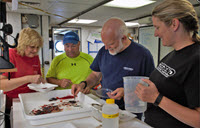Monthly Archives: March 2018

Nikaela Flournoy’s scientific journey has always carried a societal tie, from her passion for research’s social relevance to her realizations about the relationship between society and STEM (science, technology, engineering, and math). Though she is excited to see a greater emphasis on STEM in primary and secondary education, she hopes to help expand STEM awareness Read More
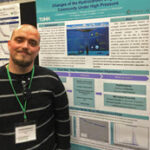
The Deepwater Horizon incident occurred at 1500 m depth, where the pressure is approximately 15 MPa, but little is known about how such high pressure affects the metabolic processes involved with oil biodegradation for bacteria that live there. Steffen Hackbusch conducts laboratory experiments that incubate microbes collected from deep-sea Gulf of Mexico sediment in seawater Read More

Free, downloadable classroom materials covering topics ranging from bioluminescence, marine environments, hydrothermal vents, food webs and Light in the deep sea – including curricula and experiment instructions. Grades 9th – 12th Bioluminescence Candy Chemosynthesis Hydrothermal Vent Food Web Oceanographic Terms and Equipment ROV in a Bag Water-down Topographic Map Marine Environments Teaching Module Light in Read More

Free, downloadable classroom materials covering topics ranging from the BP Oil Spill and its aftermath explored through art, marine environments, hydrothermal vents, food webs and light in the deep sea – including curricula and experiment instructions! Grades 6th – 8th Hydrothermal Vent Food Web Light at the Bottom of the Deep, Dark Ocean? Marine Environments Read More
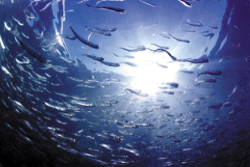
Free, downloadable classroom materials covering topics ranging from bioluminescence to hydrothermal vent food webs and include curricula, experiment instructions, and coloring sheets! Taking Science Deeper Activities Grades K – 5 Book 1: Introduction to the Deep Sea Book 2: Deep-Sea Animals Book 3: Hagfish Day! Book 4: Ocean Currents and Pollution Awareness Coloring Sheet – Read More
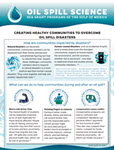
Ever wonder how individuals and communities can best recover from an oil spill? Check out our latest fact sheet. Find out what can we do to help communities during and after an oil spill. Human-caused disasters, such as accidental oil spills, tend to break down even the strongest communities. Impacts to human health, the environment, Read More
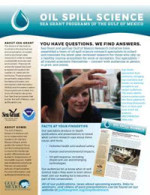
The Sea Grant Oil Spill Outreach Team is a team of oil spill science outreach specialists to collect and translate the latest peer-reviewed research for those who rely on a healthy marine ecosystem for work or recreation. Our specialists – all trained scientists themselves – connect with audiences in person, in print, and online. Our Read More
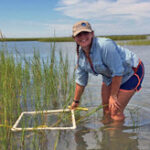
Major disturbances such as oil spills can significantly affect populations of vulnerable saltmarsh species, which may result in greater impacts to the overall saltmarsh food web. Shelby Ziegler believes that a better understanding of what saltmarsh predator-prey interactions look like today can help identify changes in the food web following disturbances in the future. “If Read More
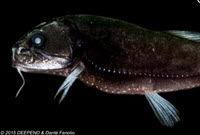
The Smithsonian’s Ocean Portal published an article about the diverse deep sea species found in the Gulf of Mexico following the Deepwater Horizon incident. The DEEPEND research consortium identified nearly 800 different species in Gulf waters, including 180 species not previously observed in the Gulf of Mexico region. Read the article The Gulf of Mexico: Read More

The Sea Grant Oil Spill Outreach Team released a product that gives a concise overview of the Stafford Act (1988) and the Oil Pollution Act (1990) that govern oil spill response. Also explained are how the National Response Framework, the National Contingency Plan, and the Oil Spill Liability Trust Fund fit into the picture. Read Read More
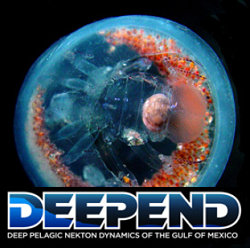
Researchers performed 99 trawl deployments (over 500 samples) during five Gulf of Mexico research cruises. The photographic timeline progresses through catches from different cruise trawls to highlight deepsea biodiversity, including some extremely rare deepsea species. Explore the timeline here!

Dr. Shivarudrappa is a Coastal Waters Consortium (CWC) researcher who examines the taxonomic identification of benthic invertebrate fauna to assess how the 2010 Deepwater Horizon oil spill impacted their community. Learn more about his research and scientific journey here.
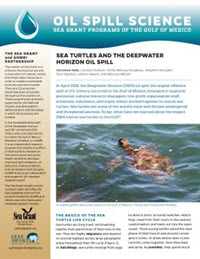
In April 2010, the Deepwater Horizon (DWH) oil spill, the largest offshore spill in U.S. history, occurred in the Gulf of Mexico. Emergency response personnel, natural resource managers, non-profit organization staff, scientists, volunteers, and many others worked together to rescue sea turtles. Sea turtles are some of the world’s most well-known endangered and threatened animals. Read More

